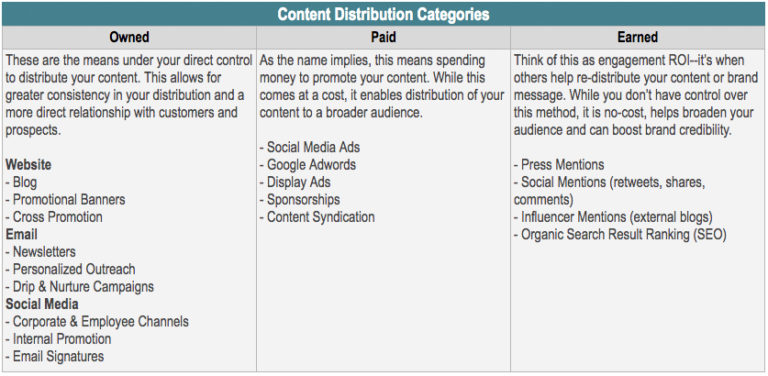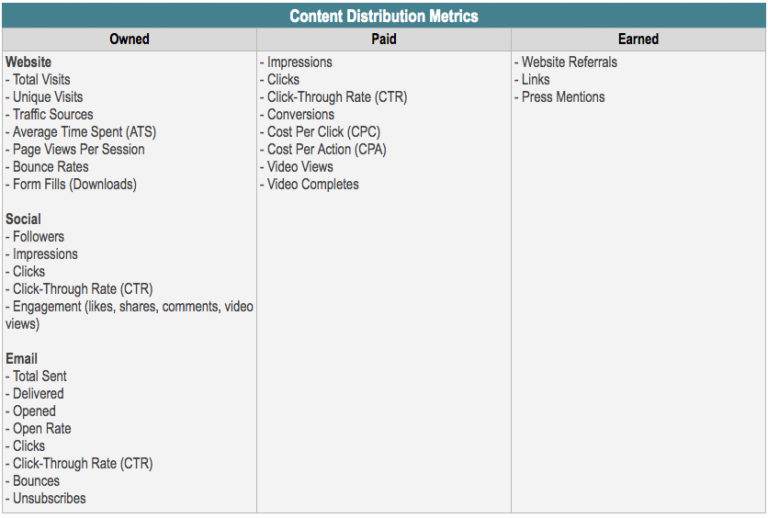Imagine if you painted a modern masterpiece, composed the world’s most beautiful concerto or wrote a novel that could change the world, and your creation just sat in a corner or in a drawer or was forgotten among the many other files on your computer. Without a distribution plan to share your content with an audience, your hard work has no opportunity to inspire, inform or drive the change or results you’re trying to achieve.
Ever hear of the 80/20 theory for content marketing? The idea is you spend 20% of your time creating content and 80% of your time sharing and promoting it. That may sound like a lot of legwork, but it doesn’t have to be if you develop a framework for how you deliver your content most effectively to the people you want to see it. Then you can adjust elements within the framework to address the goals you’ve set for each piece of content you create.
Since the majority of content produced these days is digital, it should come as no surprise that the primary focus of your distribution framework should be digital as well. And while the digital distribution world is vast and can be complex, having a solid understanding of its key components can help you develop the framework that works best for your organization and for reaching your content goals.
Digital content distribution: The what, the where and the how
When it comes to content distribution, there are three primary categories: Owned, Paid and Earned. Each of these categories includes different forms of content and, just as each piece of content is designed to play a different role in your content strategy, each distribution category plays a different role in your content distribution strategy. When used together, they ensure the most effective reach and ROI for the content you’ve produced.

Perhaps one of the toughest components of your content distribution strategy is figuring out an appropriate budget, because this is not a one-size-fits-all effort. It really comes down to who you’re trying to target, where they spend their time online and what you’re willing to spend.
If it’s your first time running paid content distribution, start with where you’re comfortable. Set a low daily budget and test to see what works. The great thing about paid media is that you can perform A/B tests for headlines, descriptions and creative (images, video) to optimize the best-performing variants and maximize both your impact and your investment.
It’s time to double-down on strategy
When you first developed your content you started with a strategy about what you wanted to say and who you wanted to hear your message. Hopefully that strategy also defined the best format for your message (webinar, blog, podcast, video, LinkedIn article, etc.), influenced by how and where your target audience consumes their content. Because this is critical for effective distribution.
As you probably know, what works for one channel doesn’t work as well for others. When stretched, marketers sometimes copy the same message from channel to channel without regard for how audiences usually interact with that channel. Knowing where your audience goes is the first step. Knowing the difference between the content that works best on Twitter versus Instagram versus LinkedIn is another critical aspect of your strategy.
In the same way you’ve probably put together a schedule for content creation, create a calendar for content distribution. This is not about imposing deadlines; it’s about mapping out where your content goes, when it goes and how often. Not only does this allow you to address any redundancies, overages or gaps, it helps you maintain a cadence that feeds audience expectations and drives engagement with its consistency.
And when it comes time to measure the impact of your content distribution efforts, be sure to set clear performance goals and commit to looking at an appropriate range of analytics over an appropriate period of time. Whether it’s day-to-day or periodic campaigns you should already know whether the content you’re distributing is for lead generation, brand awareness or some other specific purpose.
Your KPIs should match that purpose. Don’t look at the numbers and decide mid-stream that your lead-gen effort is now a brand-awareness project. It’s important to consistently track performance in order to create your own internal benchmarks. If you don’t have highs and lows to learn from, you’ll never be able to make the adjustments that strengthen your future strategy.
The digital marketing world offers multiple potential KPIs that could influence your next move. With so many different channels and tools it can be hard to determine what metrics matter. Take a step back and choose metrics that align with your content distribution goals. Below are some examples of key metrics to track when running your next campaign.

Finding the tools to extend your reach
Even with a framework in place, this all may seem daunting without a dedicated content marketing team or an outside consultant. If you’re not able to scale an internal team or outsource your activities, the following examples represent resources that can help with some of the heavy lifting of your digital content distribution efforts.
- HubSpot: Since its founding in 2006, HubSpot has grown from a pioneer in inbound digital marketing to become a one-stop-shop for social media marketing, content management, web analytics, landing pages, customer support, and search engine optimization software.
- Pardot: This marketing automation solution offered by Salesforce focuses on the specific needs of B2B organizations, including lead generation, dynamic email campaigns, and ROI tracking and reporting.
- Marketo: With lead-generation and multichannel campaign offerings for B2B and B2C customers, Adobe’s Marketo platform helps organizations automate and measure marketing engagement, tasks, and workflows.
While these are some of the most popular tools in the market, they by no means represent the full range of solutions available to you. The good news is there are plenty of “best of” lists out there that will break down features so you can compare to see what tool or combination of tools works best for you and your needs.
Ultimately, none of your content efforts should exist in a vacuum. In fact, it might be helpful to think of “Content Production” in broader terms–more like an umbrella that covers content creation plus content distribution and marketing. Because from beginning to end they’re all part of the same system, working together to help turn your content vision into reality.
marketers grapple with the Content Conundrum – the delicate balance between quantity and quality. This blog explores the challenges posed Read more
When startup marketers get content right, they can turn a prospect into a customer. Learn more about successful content marketing Read more
Content marketers face big pressure to generate quality leads. SUM shares 3 best practices for using content to engage prospects Read more
There are 4 unique ways to create a stronger thought leadership platform - and you probably haven't thought of any Read more





